
Yangon and Around
Yangon
Yangon, the capital city of Myanmar, is so evergreen and cool with lush tropical trees, shady parks and beautiful lakes it has earned the name of “The Garden City of the East”. Though with the atmosphere of a typical Asian city, It stands out in contrast as it is not yet overwhelmed with the global trends of modernity and is making its own progress at its own pace, in its own calm, civic culture. Being the main entrance to the country and principle seaport, it is the hub of business activities and government offices as well as non-governmental organizations.
It also serves as the center for higher learning as it abounds with educational institutions. The city represents a mixture of diverse communities and cultures, with respect to people, religion, business, and settlement. Yangon was founded by King Alaungpaya on the site of a small town called Dagon when he conquered lower Myanmar in 1755. He changed its name to Yangon, which means “End of Strife”, but was anglicized as Rangoon by the British when they annexed Myanmar in 1885. The present day Yangon covers an area of 350 sq. km with a population of over 5 million.
The Shwedagon Pagoda
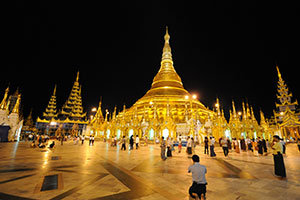 Towering to a height of 326 feet on Theingottara hill, dominates Yangon. Visitors to Myanmar are awe-struck on seeing the magnificence and splendor of this golden shrine. Ralph Fitch, the first Englishman to arrive in Myanmar’s in 1558, comment: ” it is called Dagon and is of a wonderful bigness, and all gilded from the foot to the topped – it is the fairest place, as I suppose, that is in the world.” Rudyard Kipling inscribed “this most famous of all Myanmar shrines as a golden mystery lofty on the horizon, a beautiful wonder that blazed in the sun,” in his letters from the east published in 1889. In his Gentleman in the Parlor, Somerset Maugham, at his first sight of the Pagoda was inspired to write that the superb, glistening, golden Shwedagon rising superbly upwards, was “. Like a sudden hope in the dark night of the soul. The great golden Shwedagon Pagoda is the prominent landmark visible from miles around, where the holy hair relics of the Buddha were enshrined more than 2,500 years ago. It is one of the wonders of the world and the most venerable pagoda in Southeast Asia.
Towering to a height of 326 feet on Theingottara hill, dominates Yangon. Visitors to Myanmar are awe-struck on seeing the magnificence and splendor of this golden shrine. Ralph Fitch, the first Englishman to arrive in Myanmar’s in 1558, comment: ” it is called Dagon and is of a wonderful bigness, and all gilded from the foot to the topped – it is the fairest place, as I suppose, that is in the world.” Rudyard Kipling inscribed “this most famous of all Myanmar shrines as a golden mystery lofty on the horizon, a beautiful wonder that blazed in the sun,” in his letters from the east published in 1889. In his Gentleman in the Parlor, Somerset Maugham, at his first sight of the Pagoda was inspired to write that the superb, glistening, golden Shwedagon rising superbly upwards, was “. Like a sudden hope in the dark night of the soul. The great golden Shwedagon Pagoda is the prominent landmark visible from miles around, where the holy hair relics of the Buddha were enshrined more than 2,500 years ago. It is one of the wonders of the world and the most venerable pagoda in Southeast Asia.Karaweik Hall
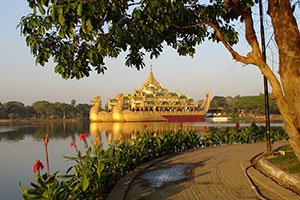 Karaweik Hall is one of the landmarks of Yangon, standing in the Kandawgyi Lake(Royal Lake ). This modern architecture is built in the shape of the mythical creature Karaweik bird. It has 3 floors including a ceremonial hall. This wholly gilded building is about 20 years old.to write that the superb, glistening, golden Shwedagon rising superbly upwards, was “. Like a sudden hope in the dark night of the soul. The great golden Shwedagon Pagoda is the prominent landmark visible from miles around, where the holy hair relics of the Buddha were enshrined more than 2,500 years ago. It is one of the wonders of the world and the most venerable pagoda in Southeast Asia.
Karaweik Hall is one of the landmarks of Yangon, standing in the Kandawgyi Lake(Royal Lake ). This modern architecture is built in the shape of the mythical creature Karaweik bird. It has 3 floors including a ceremonial hall. This wholly gilded building is about 20 years old.to write that the superb, glistening, golden Shwedagon rising superbly upwards, was “. Like a sudden hope in the dark night of the soul. The great golden Shwedagon Pagoda is the prominent landmark visible from miles around, where the holy hair relics of the Buddha were enshrined more than 2,500 years ago. It is one of the wonders of the world and the most venerable pagoda in Southeast Asia.The colonial buildings in and around Yangon
Advance to the west is the Office of Myanmar Harbor authority with an uprising tower in the Pansodan Street . And the Yangon Division court resembles Queen-Ann-Style English architecture. Other remarkable colonial style buildings are the Yangons station decorated with typical Myanmar traditional arts, the Mee Ya Htar building (used to be Myanma railway office) built of red brick in colonial architecture, the Bogyoke Aung San Market and the Holy Trinity Anglican Cathedral in the typical English colonial style painted in dominantly red color. All these structures are on Bogyoke Aung San Street , as is the Yangon General hospital, which was the first public building in Myanmar and was constructed in 1911. Constructs red brick equalized with yellow, this enormous structure characterizes a lot of large arches and appearing to turrets indistinctly. The other indubitable English time public building is Ministerial office, which occupies the whole block of land surrounded by Anawrahta, Thein Byu, Mahabandoola and Bo Aung Kyaw streets.
Bogyoke Aung San Market
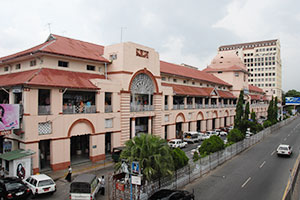
It is a fantastic prewar structure in Yangon known as Scott Market before. It is the most famous shopping place in Yangon . Myanmar arts and handicrafts are best souvenirs available there at reasonable price. Lacquer wares, wood and ivory carvings, tapestries, silverware, brassware, silk and cotton fabrics, and shoulder bags as well as jewelry are some of the most favorite items it has to offer.
Chaukhtatgyi Pagoda
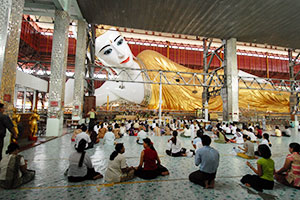
Located 10 minutes away from downtown, and 5 minutes from the famous Shwedagon Pagoda, the 72 meters long reclining Buddha image is the biggest colossal reclining Buddha image in Myanmar. Originally built in 1907, it has suffered damage due to climate over the years. In 1957, it was demolished and rebuilt to this structure and completed in 1966. The uniqueness of the image is the glass mosaic on the sole of its feet representing the 108 special characteristics of the Buddha.
Botahtaung Pagoda
Hlawga Wildlife Park
Htaukkyant war cemetery
Located at Htaukkyant, about 32 km from Yangon on the road to Bago, there is a memorial cemetery of Allied soldiers who died in the Burma Campaign during World War II. The cemetery’s beautifully kept compound has 27,000 tombstones of fallen Common Wealth and Allied soldiers.
Bogyoke Aung San Museum
Natural history Museum
National Museum
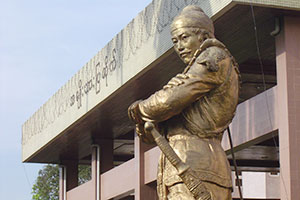
Located on Pyay Road, about a few minutes away from downtown, the newly built five-storied museum will let you know the glory of Myanmar. It exhibits the Lion Throne of the last Myanmar king, royal regalia of 19th century Myanmar kingdom, artifacts of various ancient periods, articles of cultural heritage and archaeological value, art and craft articles, weaponry, musical instruments and paintings.
Myanmar Gems Museum
Strand Jetty
The jetty is situated in front of the famous Strand Hotel. From there, you may observe the daily lives of people who came across the river from the other side of the city for working or selling their local products. You can cross the river by ferry boat, which takes about 10 minutes to return.
Sule Pagoda
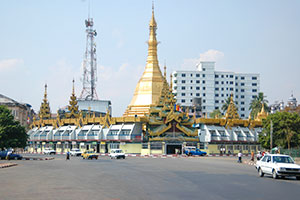
The landmark at the Yangon City center and symbol of downtown Yangon is situated right at the heart of the city. The Sule Pagoda is said to be over 2,000 years old, enshrining a hair relics of the Buddha. The golden pagoda is unusual in that its octagonal shape continues right up to the top terrace. It stands 46 meters (152 feet) high and is surrounded by small shops of all the familiar non-religious services such as astrologers, palmists, photo studios and watch repair. From there, you may observe the atmosphere of the Yangon center with crowed people from all walks of life in various trades, and busy traffic.
Kabar Aye Pagoda (World Peace Pagoda)
Kyauktawgyi Pagoda
Zoological GardenaThanlyin (Syrium)
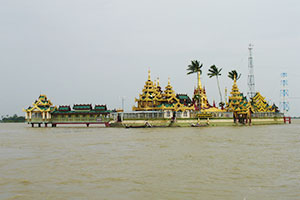
Once the center of foreign trade for all lower Myanmar. In 16th century Syrium was home to trading port of Portuguese, Dutch, French and British merchants. Later the Portuguese adventure de Brito established his own private kingdom. The ruin of a Catholic church built by an Italian missionary in the 18th century can still be seen today. During the colonial days the British have imported some one millions of Indian for rice cultivation. Syrium still host a great numbers of Indian population though Myanmar citizen but their customs and way of life are still very much determined by the Hindu religion.
Kyeikkhauk Pagoda
Twantay
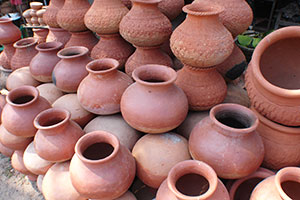
24 km from Yangon, reachable by road in an hour or by boat in about two hours on the Twantay Canal. The boat trip provides a view of the life along the canal while Twante itself provides interest as a center of pottery and hand-woven cotton cloth. There are over fifty pottery works. This craft has been handed down from generation to generation and is still carried on in the time-honored tradition. Twantay pottery is recognized and distributed throughout the country. Thousands of water pots flower pots, basins, jars of from 5 to 25 viss capacity are produced daily.
Bago
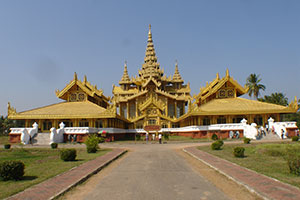
Do you want to see the country’s highest golden pagoda? Or the Reclining Buddha 55 m in length and 16 m in height? Or Kyaukpun Pagoda’s four huge seated Buddhas – sitting back to back facing the four points of the compass? Would you like to follow the studies of Buddha’s teachings with the monks of Kyakhatwaing monastery? Or rather just stroll across and enjoy the extensive river market? Well, it is time to follow us to Bago. At a 2 hours´ drive from Yangon we visit the former capital of the Mon-People. We travel Myanmar’s only “freeway”. While returning, you will have the chance to visit the temple (home of the nats according to local lore) dedicated to the guardian of traveling where motorists offer flowers to pray for a safe journey. Bago, called Pegu by the British and once an important sea harbour (before it silted up), has been reborn!
Kyaikhtiyo
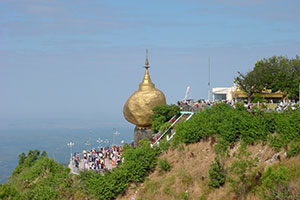
Reaching the Golden Rock 25 years ago meant a journey of several days on elephants´ back, nowadays the trip takes about 6 hours to Kinpun. This important venue for pilgrims is at the foot of a mountainous region and close to the Golden Rock. We leave Kinpun aboard pickups (sitting on small stools in the back) for a half hours´ steep climb and descend to reach the middle station with a more or less new hotel. From here it is a 1 hour’s climb by foot to reach the Golden Rock, where you pass the original hotel near the rock. Those not wanting to climb can hire a porter who takes them uphill in a bamboo chair. The reward is breathtaking: Way above the valley’s jungles, reaching far beyond a cliff, the mighty rock, encrusted with gold leaves by faithful Buddhist pilgrims, its peak crowned by a small pagoda! A hair of the Buddha is said to be enshrined here. And it is this one hair that holds the huge boulder, perched on a cliff, from tumbling into the abyss below – the magic of believing!
Thaton
Mawlamyine/Moulmein
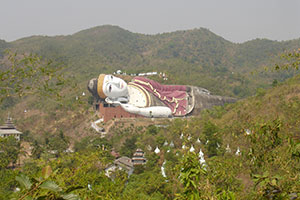
When the British established their Colony, Burma, in the 19th century, they made Moulmein their first capital and this explains the perseverance of its colonial charms to our days. Famous British authors wrote about its former grandeur. Today, Mawlamyine is number three in size among the cities of Myanmar, situated 270 km SE from the capital. The surrounding hills – crowned with pagodas – afford the best view of the city on the river Salween which here joins the Gulf of Martaban. The city also can be reached by ancient ferries which connect Mottama (Martaban) with Mawlamyine. The city is attractive and offers pagodas as well as churches for visits. Exploration of the surroundings show special sights such as the strategically relevant building site of the infamous “railroad of death” (to be reached via Kyaikhami/Amherst, about 60 km). Planned by the Japanese, this railroad was to connect Burma via Thailand with Singapore (The Bridge on the River Kwai). A well-tended cemetery for allied POWs working on and dying for this railroad reminds us of these grievous times. Along the way several remarkable pagodas as well as the building site near Mudon of a 160 m Reclining Buddha enhance these excursions. Moreover the ever close beaches beckon to rest …
Hpaan

Hpaan, capital of Kayin State, is surrounded by lovely hills and mountains. This is perfect hiking country with its small lakes and many grottoes. Moreover taking time to enjoy the local market is a delightful experience. The colourful costumes of the Kayin women are a sight-to-be-seen. Hpaan is in between Mawlamyine and Yangon.
Pathein/Bassein
Pyay/Prome
Contact Us
Information
WhatsApp : 09 250197881
info@myanmarphotographytour.com,
winthandarandassociatestravels@gmail.com
Travel Tips
- Embassies In Myanmar
- Arrival & Departure Procedure
- Myanmar Embassies Abroad
- Do & Don't
- Gazetted Holidays In Myanmar
- Life Style In Myanmar
- General information about Myanmar visa
- Travel Tips
- Our Services
- Naga History
We specialize in Myanmar also known as Burma because with our roots and our years (22 years travel industry )of experience.
